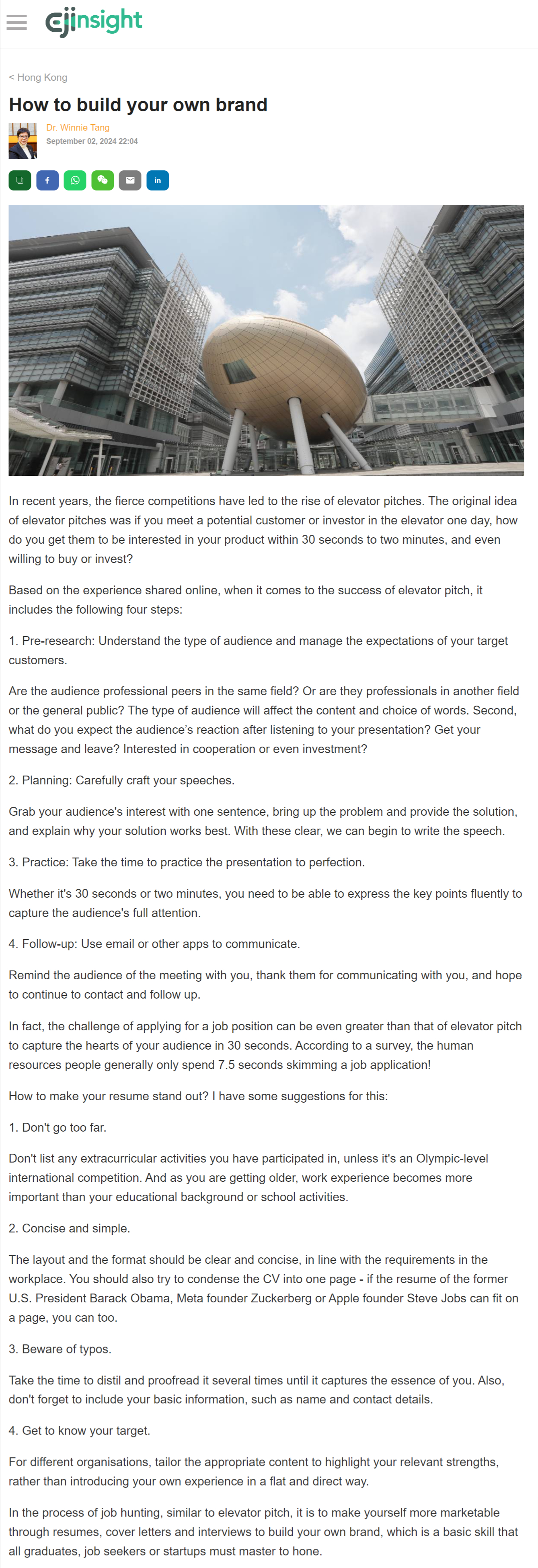網上版請按此

How to build your own brand
In recent years, the fierce competitions have led to the rise of elevator pitches. The original idea of elevator pitches was if you meet a potential customer or investor in the elevator one day, how do you get them to be interested in your product within 30 seconds to two minutes, and even willing to buy or invest?
Based on the experience shared online, when it comes to the success of elevator pitch, it includes the following four steps:
1. Pre-research: Understand the type of audience and manage the expectations of your target customers.
Are the audience professional peers in the same field? Or are they professionals in another field or the general public? The type of audience will affect the content and choice of words. Second, what do you expect the audience's reaction after listening to your presentation? Get your message and leave? Interested in cooperation or even investment?
2. Planning: Carefully craft your speeches.
Grab your audience's interest with one sentence, bring up the problem and provide the solution, and explain why your solution works best. With these clear, we can begin to write the speech.
3. Practice: Take the time to practice the presentation to perfection.
Whether it's 30 seconds or two minutes, you need to be able to express the key points fluently to capture the audience's full attention.
4. Follow-up: Use email or other apps to communicate.
Remind the audience of the meeting with you, thank them for communicating with you, and hope to continue to contact and follow up.
In fact, the challenge of applying for a job position can be even greater than that of elevator pitch to capture the hearts of your audience in 30 seconds. According to a survey, the human resources people generally only spend 7.5 seconds skimming a job application!
How to make your resume stand out? I have some suggestions for this:
1. Don't go too far.
Don't list any extracurricular activities you have participated in, unless it's an Olympic-level international competition. And as you are getting older, work experience becomes more important than your educational background or school activities.
2. Concise and simple.
The layout and the format should be clear and concise, in line with the requirements in the workplace. You should also try to condense the CV into one page - if the resume of the former U.S. President Barack Obama, Meta founder Zuckerberg or Apple founder Steve Jobs can fit on a page, you can too.
3. Beware of typos.
Take the time to distil and proofread it several times until it captures the essence of you. Also, don't forget to include your basic information, such as name and contact details.
4. Get to know your target.
For different organisations, tailor the appropriate content to highlight your relevant strengths, rather than introducing your own experience in a flat and direct way.
In the process of job hunting, similar to elevator pitch, it is to make yourself more marketable through resumes, cover letters and interviews to build your own brand, which is a basic skill that all graduates, job seekers or startups must master to hone.
Dr. Winnie Tang
Adjunct Professor, Department of Computer Science, Faculty of Engineering; Department of Geography, Faculty of Social Sciences; and Faculty of Architecture, The University of Hong Kong